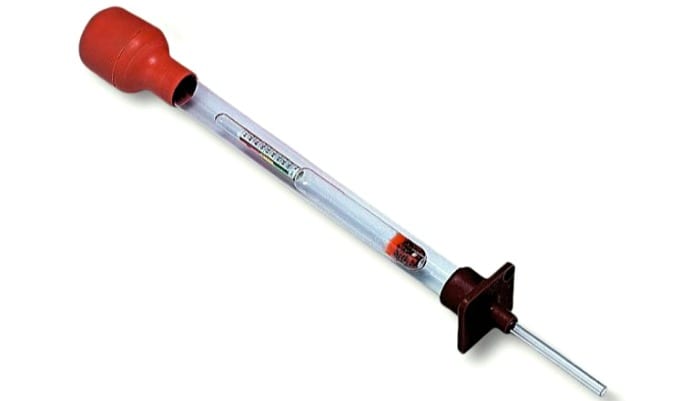
What is a hydrometer? The principle of operation and what is needed
Content
During car maintenance, periodically you need to measure the density of the electrolyte and antifreeze. Visually, this parameter cannot be determined. For such purposes, there is a hydrometer.
How is this device arranged, how does it work, what varieties exist and where else do they use it? Answers to these questions will help novice motorists use the hydrometer correctly.
What is a hydrometer?
The density of a liquid is the concentration in the basic medium of an additional substance. The knowledge of this parameter helps to determine at what point the technical fluid needs to be replaced or makes it possible to find out whether the manufacturing technology is followed at the factory.
Motorists use a hydrometer to measure the quality of electrolyte and antifreeze. The low content of additional substances in the main medium can lead to freezing of the liquid in frost or a decrease in its level due to the rapid evaporation of water in hot summers.
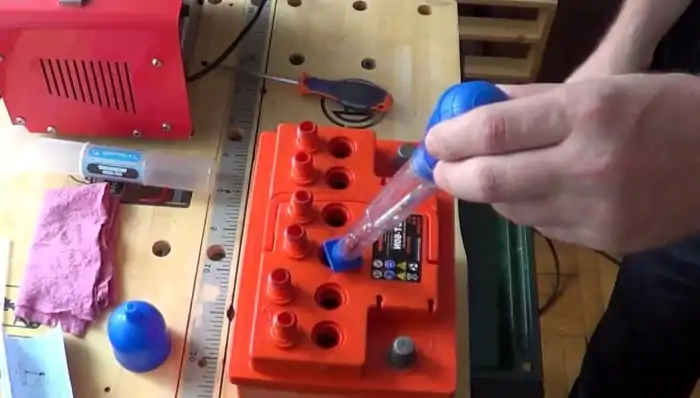
In the case of the battery, this will lead to difficulties in starting the engine, reducing the working life or decay of lead plates. A low-density coolant can boil at a lower temperature.
To prevent the occurrence of problems, it is necessary to measure these liquids in a timely manner with the help of a hydrometer - a glass float with a scale. It is very simple to use, but some factors must be taken into account.
Principle of operation
According to legend, the ancient Greek scientist Archimedes plunged into a crowded bath, because of which water began to pour out. This situation led him to the idea that in the same way it is possible to measure the volume of gold from which the crown of King Heron II was made (the inventor was given the task to determine whether precious jewelry was made of pure gold).
Any hydrometer operates on the principle of crowding out, discovered by Archimedes. According to the hydrostatic law, when an object is immersed in a liquid, a buoyant force acts on it. Its value is identical to the weight of the displaced water. Since the composition of the liquid is different, the buoyancy force will be different.
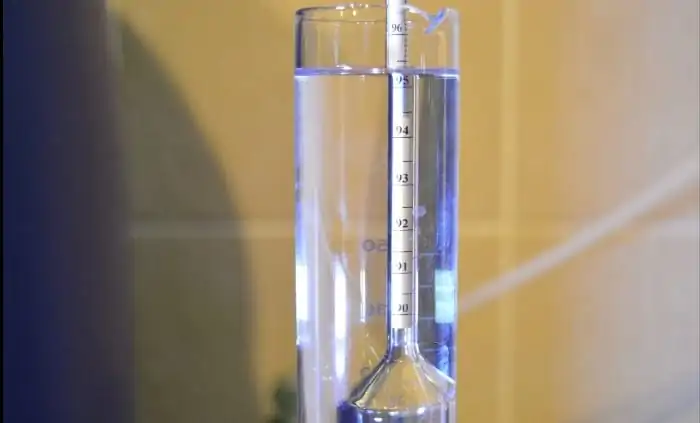
A sealed flask is placed in the main container with liquid. Since the weight is fixed at the bottom of the device, the flask does not turn over, but retains a vertical position.
In the case of local measurement, as in determining the density of antifreeze or electrolyte, hydrometers are used with a tank in which the float is placed. During sampling, the liquid fills the main flask to a certain level. The deeper the second flask sinks, the lower the density of the liquid. To determine the quality of the medium being tested, you need to wait until the "float" calms down.
Types of devices
Since liquid substances have their own density, then hydrometers are calibrated for each of them individually. If the device is not used for its intended purpose, its performance cannot be considered correct.
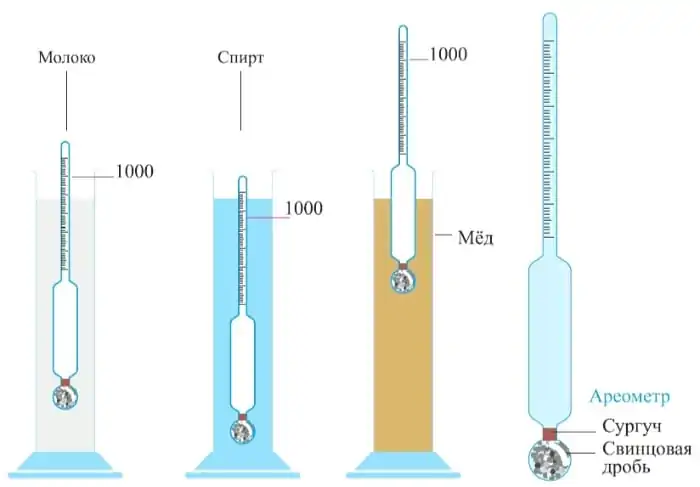
In addition to the weight of the weight calibrated for the corresponding liquid, the device can have three types of scales:
- To determine the density of a substance;
- To measure the percentage of impurities in the medium;
- To determine the percentage of additional substance dissolved in water (or other basis), for example, the amount of sulfuric acid in the distillate to prepare the electrolyte.
Outwardly, all hydrometers are similar to each other and work on the same principle, but each of them is calibrated for its own environment and for specific parameters.
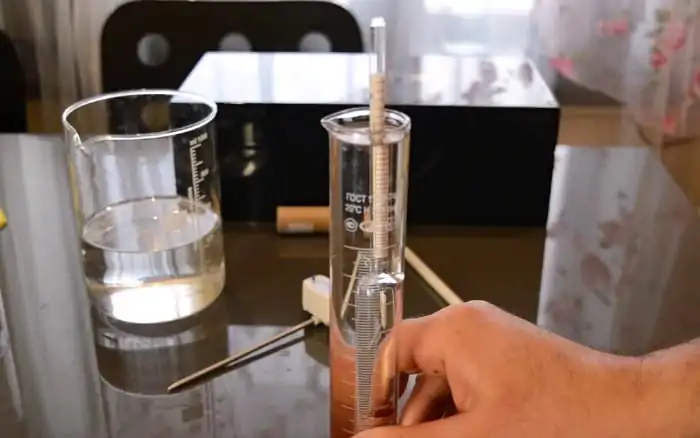
Similar devices are used to measure indicators:
- The percentage of alcohol;
- Concentrations of sugar or salt;
- Density of acid solutions;
- Fat milk;
- The quality of petroleum products.
Each modification of the hydrometer has a corresponding name.
Alcohol meter
Allows you to measure the strength of an alcoholic drink. In this case, its scale will show the percentage of alcohol in the drink. It is worth considering that such devices are not universal, but also calibrated for certain categories of drinks.
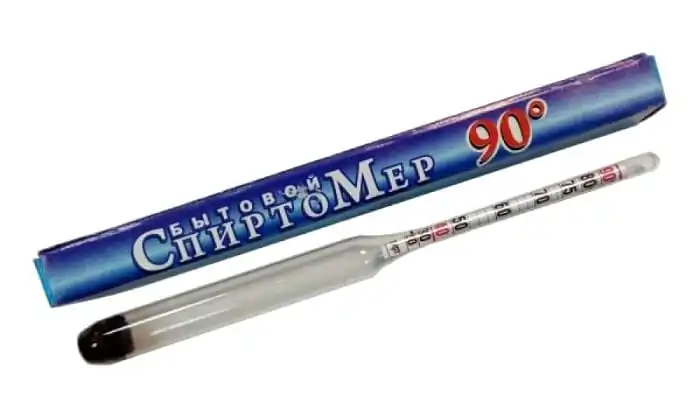
For example, hydrometers are used to measure vodka, liquor and other strong drinks, the graduation of which is within 40 degrees. In the case of wine and another low alcohol, more accurate flasks are used.
Hydrometer for oil products
This category of devices is designed to measure the quality of gasoline, kerosene, diesel fuel and other petroleum products. The device allows you to determine the presence of impurities that reduce the quality of the fuel.
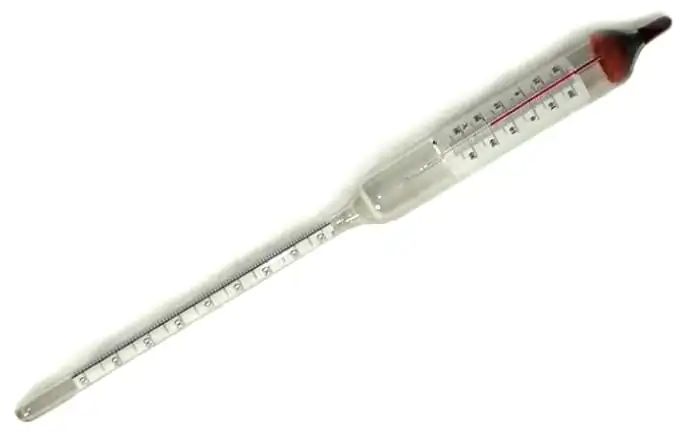
They are used not only in industrial enterprises. An ordinary motorist can also purchase such a device to make it easier to determine at which gas station it is worth refueling your car.
Saccharometer
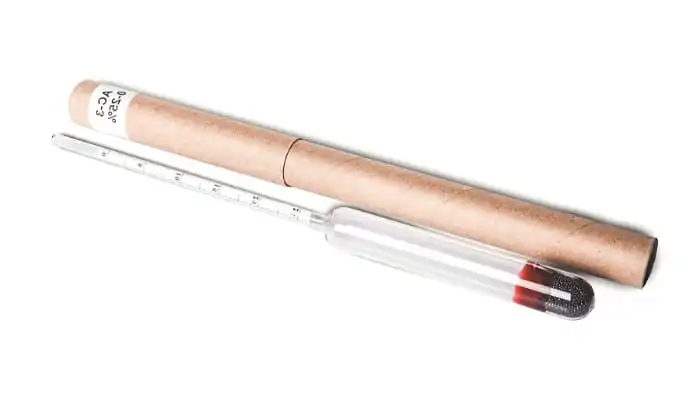
Refractometers are used in the food industry mainly in enterprises engaged in the preparation of juices. The device allows you to check the ripeness of the fruit. With its help, the concentration of sugar in the test medium is measured.
Car hydrometer
Motorists use hydrometers to measure the density of antifreeze and electrolyte. Less commonly used to measure brake fluid and gasoline. In the case of models for testing acidic liquids, the instrument is slightly modified.
Additionally, it has a large hollow flask, inside which a glass float with an appropriate scale is placed. On the one hand, such a device is narrowed (or with a rubber nozzle like a pipette), and on the other, a rubber bulb is put on it to take a portion of the electrolyte.
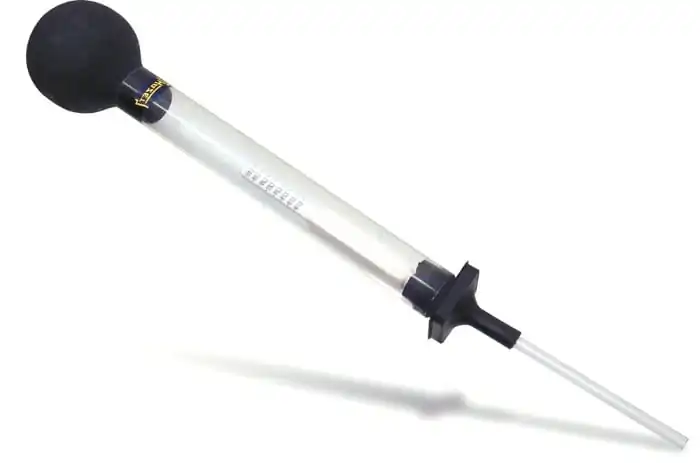
This design is the safest, since contact of acidic and toxic substances with the skin is undesirable. Most car models are universal and are used to measure the density of different liquids.
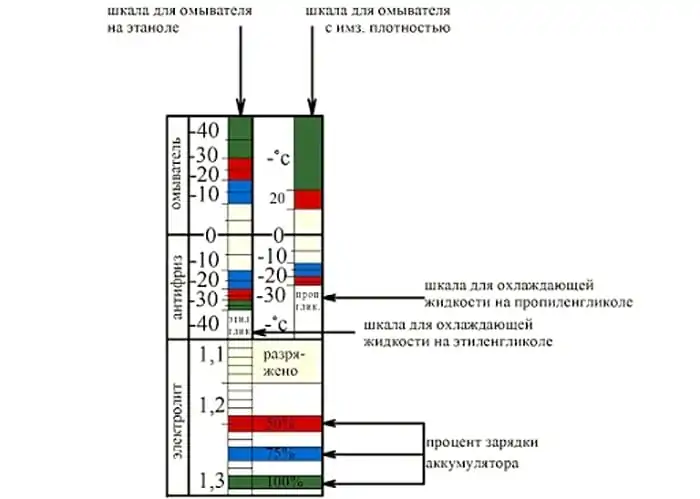
Since the float in a separate medium dives to its depth, the parameters corresponding to a particular liquid are plotted at different levels of the scale.
In addition to the above modifications, hydrometers are also used in medicine (for measuring the density of some biological materials of humans), in cooking, in the food industry (for example, a lactometer measures the fat content of milk, and a salimeter helps determine the suitability of water for food purposes and its hardness), as well as enterprises producing chemical products.
Design and parameters of hydrometers
The device is a flask sealed at both ends. Inside it there is a metal fraction. Its amount is determined by the purpose of the device (each liquid has its own density). A scale is applied to the flask, which allows you to accurately determine the desired parameter. Some hydrometers are additionally placed in a large hollow tube (as is the case with the model for electrolyte).
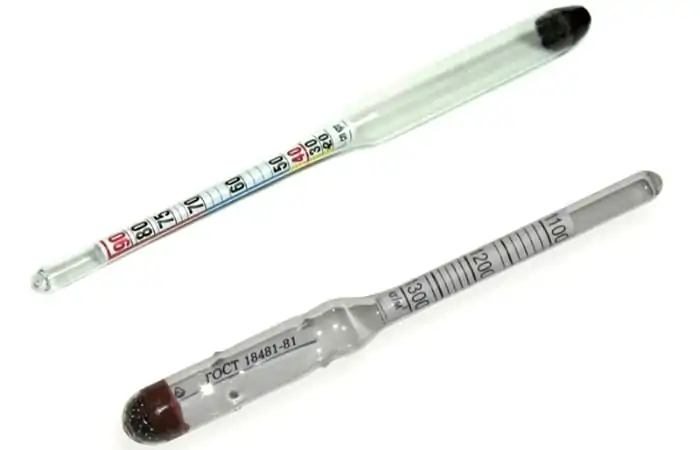
An additional flask is used to measure some hazardous liquids. It is designed to take portions (for example, car hydrometers make it possible to accurately take a small amount of electrolyte). This design prevents electrolyte or other toxic material from getting on the skin.
Depending on the design and purpose, the second flask can be made in the form of a bottle with a long neck or in the form of a thick test tube with a scale applied. Some models are made of dense transparent plastic that is resistant to aggressive acid and alkaline solutions.
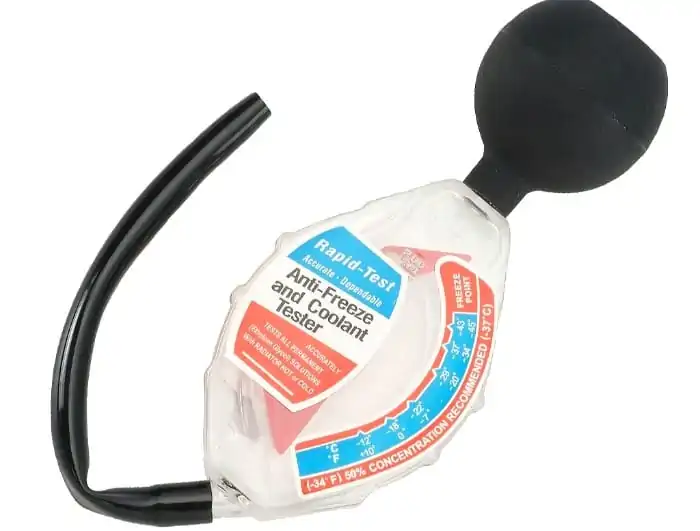
The glass analog has several advantages:
- The bulb retains its transparency regardless of frequency of use;
- Glass is more resistant to organic compounds.
One of the drawbacks of glass hydrometers is that they are fragile, so a collapsible model must be properly stored (in a case with separate cells for each bulb). In this case, the float must be removed from the large flask and stored in special packaging so that it does not break.
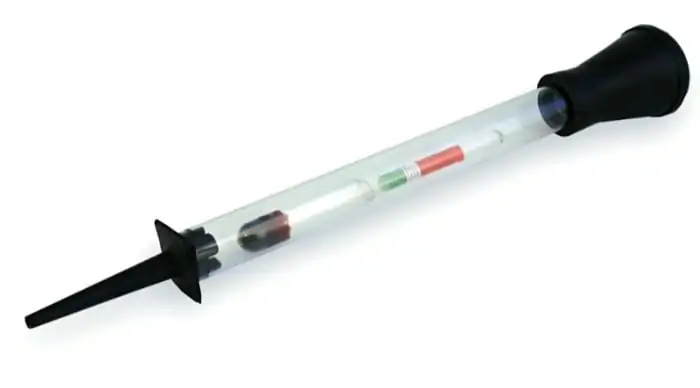
When purchasing the same type hydrometer, you should pay attention to the error (it is indicated in percent). Most often, this parameter is very important for accurate measurements in the workplace.
Also an important factor is the graduation of the scale. The longer it is, the more accurate it will be. Cheap hydrometers most often have a small scale, so the determination of the exact density indicator of electrolyte or antifreeze is complicated.
In order to make it easier for the motorist to determine whether the indicator complies with the norm, marks on the scale are marked with the minimum acceptable value (red mark). The optimal indicator is marked in green.
How to use a hydrometer
Using the device is very easy. To determine the required parameter, the float is placed in a container with a solution. He should calm down, which will give the most accurate indicator.
In the case of hazardous fluids, this procedure must take place in a special way. Since the battery’s functioning depends on the density and concentration of acid in the electrolyte, you need to periodically check these parameters using a hydrometer (on how to extend battery life, read in a separate article).
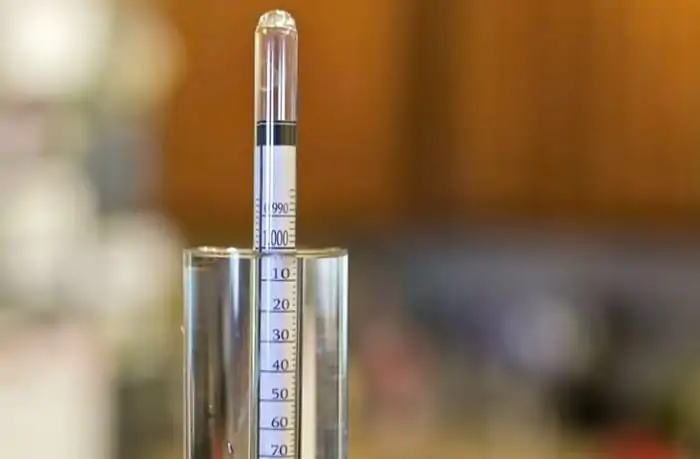
The density of the electrolyte in the batteries should be in the range of 1,22-1,29 g / cm3 (Depends on the climate in which the car is operated). Some battery models are equipped with a viewing window in which the charge indicator is placed. His indicators:
- red color - the electrolyte level has fallen, it is necessary to replenish the volume (while the charge may still be enough so that the starter can spin the flywheel);
- white - the battery is discharged by approximately 50%;
- green - the power source has enough charge.
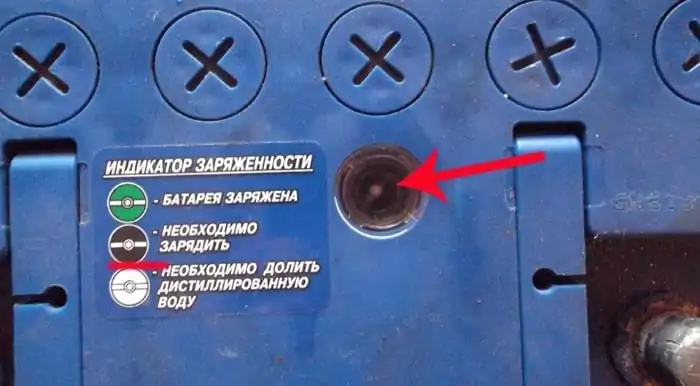
These indicators will help determine whether it is possible to use a power source for the operation of energy-intensive equipment, for example, an audio system (how to connect a car amplifier correctly, described here).
Periodic maintenance of the power source will help determine if you need to add distillate to it or if the battery needs recharging. In serviced batteries, measurements are made with a car hydrometer. Here is a short instruction on how to use it correctly.
Step-by-step instructions for taking measurements
Before measuring the process fluid, it is important to ensure that its temperature meets the requirements for this procedure. Manufacturers recommend taking measurements at a temperature within +20 degrees (not the environment, but the medium being tested). The density of the same fluid varies with different thermometer readings, so to eliminate inaccuracies, you must adhere to this recommendation.
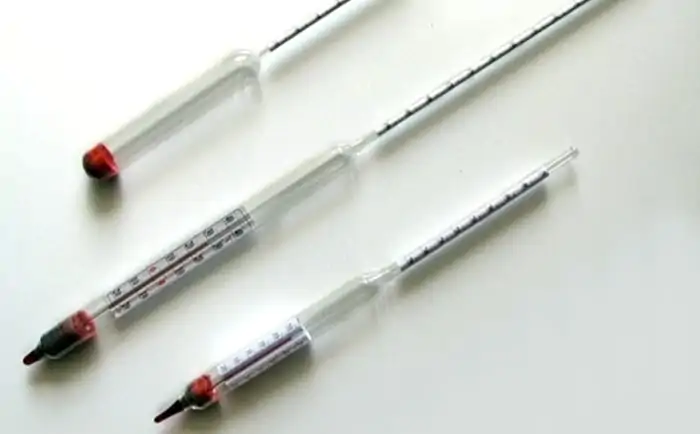
For ease of measurement, some modern modifications are equipped with a thermometer to determine the temperature of the liquid. so that you can accurately determine whether the fluid meets the required parameters, sometimes on the scale (or in the technical documentation of the device) the correction is given taking into account the non-standard temperature.
The procedure is performed in the following sequence:
- you need to make sure that at least six hours have passed since the last charge;
- all battery plugs are twisted;
- a float (hydrometer) is inserted into a large flask, a pear is put on top, and on the other hand - a cork with a narrowed neck;
- before lowering the rubber tip into the electrolyte, the pear is completely compressed;
- the pipette is immersed in a liquid, the pear is unclenched;
- the electrolyte volume should be so that the float inside the flask floats freely and does not touch the walls of the flask;
- after reading the indicators, the electrolyte smoothly returns to the battery jar, the plugs twist.
For better safety, the hydrometer must be washed with water. This will prevent the formation of plaque inside the flask, which may affect the accuracy of measurements in the future.
Measurement Safety
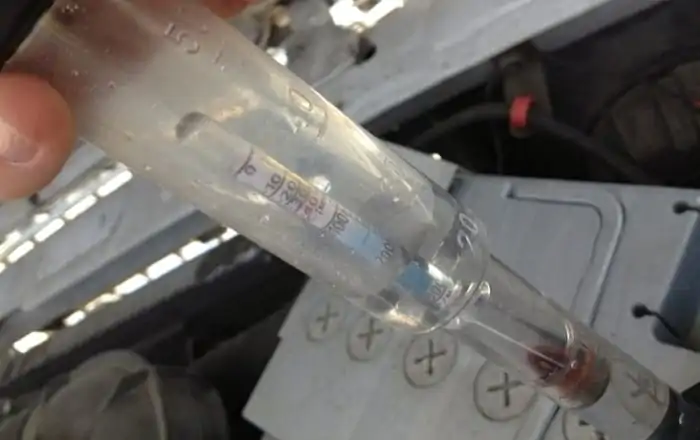
Technical fluids in a car are often toxic and can cause damage to them during prolonged contact with the skin (especially in the case of an acid solution), therefore it is important to adhere to safety precautions when working with them. Here is what every motorist should remember:
- in order to avoid contact of acid with skin of hands, it is necessary to use rubber gloves;
- during the operation of the battery, water from it can evaporate (applies to serviced modifications), therefore, unscrewing the plugs, you need to be careful so as not to inhale acid fumes;
- when working with the battery, it is strictly forbidden to smoke and use any source of open flame;
- measurements are important in a well-ventilated area;
- working with hazardous fluids does not hasten (due to carelessness, electrolyte can get on the car body and corrode metal).
Overview of popular hydrometer models
Finding a high-quality hydrometer is not difficult, because it is a fairly simple device that can be found in any auto parts store. There are several types of such devices. They differ from each other by the parameters under which they are calibrated. Here are a few popular hydrometers.
| For antifreebehind: | Estimated cost, cu | Advantages | Disadvantages |
| Jonnesway AR030002 | 8 | Compact, versatile, easy to use, reliable | Expensive |
| JTC1040 | 5 | Lightweight and compact, multifunctional (the freezing point and boiling point are marked on the scale) | It reacts poorly to prolonged contact with acids. |
| AV Steel AV-920097 | 4 | Budget price, ease of use, reliable, multi-functional | Small markings on the scale |
| For electrolyte: | |||
| Jonnesway AR030001 | 7 | Universal, lightweight, multi-colored scale, durable | High price |
| Heyner Premium 925 010 | 6 | Affordable price, plastic case, a small amount of tested electrolyte | It is stored without a case; the pear may subside over time |
| Autoprofi battery BAT / TST-118 | 5 | Easy to use, color scale, affordable price | It is used only in lead-acid battery models, the results do not always reflect the real indicator |
| JTC1041 | 4 | Budget option, bulb strength, resistant to acid solutions, measurement accuracy, compact | The float often sticks to the wall of the bulb; there is no case |
| Pennant AR-02 5002 | 2 | Lightweight, airtight, glass, cheap | Rubber bulb quickly loses elasticity, no case |
Before choosing a modification, it is necessary to consult with specialists, since every year manufacturers create new models with improved characteristics. Some modifications may be ineffective when measuring certain types of liquids.
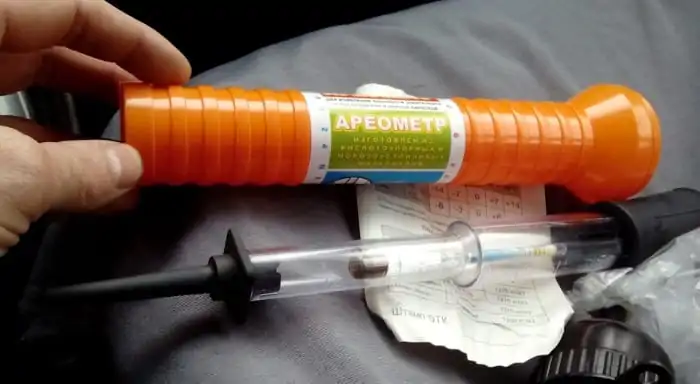
In stores, you can find universal models with which you can measure the quality of both coolant and electrolyte. Some of them have a dial and are calibrated with distilled water for any type of liquid. Practice shows that such expensive modifications are more suitable for professional service stations than for domestic use.
As you can see, the hydrometer is not a complex device with which even a novice can correctly measure the state of the electrolyte or antifreeze. Thanks to this simple procedure, the motorist will be able to significantly extend the battery life and ensure proper operation of the engine cooling system.
Related videos
Here is a short video on how to use a hydrometer to measure the electrolyte density in serviced batteries:
Questions and answers:
What can be measured with a Hydrometer? This device measures the density of any technical liquid. It works on the basis of Archimedes' law. The device for cars is designed for antifreeze and electrolyte.
What is a hydrometer and how to use it? This is a flask with a sealed hollow tube, inside which there is a metal shot. The pear is filled with liquid. Its level on the scale indicates density.
How to determine density with a hydrometer? For this, the inner tube has a graduated scale for different liquids. A simpler option is a sealed tube with a scale. It is dipped in liquid.
